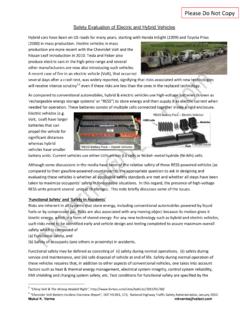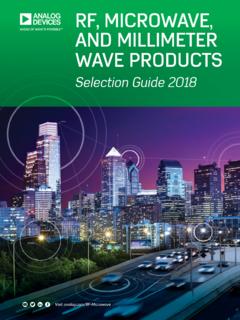Transcription of CHAPTER 21 Mechanical Design of Mixing Equipment - experts
1 CHAPTER 21 Mechanical Designof Mixing EquipmentD. S. DICKEYMixTech, B. FASANOC hemineer, INTRODUCTIONM ixing Equipment must be designed for Mechanical and process operation. Al-though mixer Design begins with a focus onprocess requirements, the mechanicaldesign is essential for successful operation. Usually, a competent manufacturer ofmixing Equipment will take responsibilityfor the Mechanical Design . However,process conditions, such as impeller operation near a liquid surface, can imposesevere Mechanical loads. Similarly, the process environment will influence theselection of a motor enclosure. In many ways the process requirements can havea direct impact on the Mechanical Design . In other ways, such as the naturalfrequency of a mixer shaft, appropriate Mechanical Design must be determinedby the Equipment designer. Whatever the reason, knowledge of the mechanicalrequirements for a mixer will help guide the engineer toward a Design that willmeet both process and Mechanical purpose of this CHAPTER is to provide practical information about themechanical Design of Mixing , descriptions, equations, andnomenclature will be given in both engineering units and metric and equations using engineering units will follow commonindustrial practices used in the United States with Design information for mate-rials measured in inches and motors specified in horsepower.
2 Descriptions usingHandbook of Industrial Mixing : Science and Practice, Edited by Edward L. Paul,Victor A. Atiemo-Obeng, and Suzanne M. KrestaISBN 0-471-26919-0 Copyright 2004 John Wiley & Sons, Design OF Mixing Equipment metric units will reference materialscommonly measured in millimeters (mm),while equations will do calculations in meters (m).Metric units in equations will follow SI metric practice. To avoid confusion,values in the text that are also used in equations will use standard SI units even ifmore reasonable numeric values are possible with prefixes. Units for variables engineering units ( Eng.) are shown in brackets []. Units for variablesin metric units (Metric) will be shown in braces{}. The nomenclature list showsboth engineering units and metric units used in the equations. Care mustbe taken to use the correct units, sinceseveral equations contain dimensionalconstants. Results can be incorrect if the wrong units are Mechanical FEATURES AND COMPONENTS OF MIXERSB ecause of the diversity of fluid mixingapplications and variety of vessels,many different styles of mixers are used in industrial applications .
3 Mixer sizesinclude small fractional-horsepower portable mixers to huge 1000 hp plus normally viewed as a single piece of Equipment , like a pump, the typicalmixer is composed of several individual components, such as a motor, gearreducer, seal, shaft, impellers, and tank, which is often designed and purchasedseparately. Although highly customized for many applications , most mixers area combination of standard components, sometimes with modifications, and oftenwith unique characteristics, such as shaft , especially for mixers ,can misrepresent individual situations,but some features are common to the largest number of mixers built most common motive force for a mixer is an electric motor, so a knowledgeof standard motor characteristics is useful. Most mixers operate at or below typ-ical motor speeds, so some type of speed reduction is common. Speed reductioncan be accomplished with several different types of gears, usually in enclosedhousings, or with belts and sheaves.
4 Besides speed reduction, antifriction bear-ings are found in all types of rotating Equipment . Some type of seal aroundthe rotating shaft is required for closed-tank operation and the type depends ondegree of seal required, operating pressure, and operating shaft for a mixer, especially a large one, involves significant mechanicaldesign, partly because of the myriad of shaft lengths, impeller sizes, and operatingspeeds, and partly because both strength and rigidity are necessary for a successfuldesign. The combination of custom process and Mechanical Design necessary formixers is unique for chemical process Equipment . Mechanical Design does notend with the shaft, since strength and practical issues remain for the part of mixer Design is the tank in which the mixer is used, sincetank dimensions influence mixer features, especially shaft length. Conversely, amixer requires tank features, such as baffles, support strength, and other tankinternals. Materials of construction, although most commonly metal alloys formixers, depend on process chemistry and operational Mechanical features can be important in special-purpose mixers , such ashigh-shear mixers , dry-solids mixers , and static mixers .
5 Without revealing tradeMECHANICAL FEATURES AND COMPONENTS OF MIXERS1249secrets or emphasizing proprietary technology, elements of the same mechanicaldesign considerations apply to special-purpose mixers . The primary mechanicalemphasis in this CHAPTER is on Equipment discussed elsewhere in this key element of the Mechanical characteristics of mixers will be coveredin this section. Although not comprehensive with respect to each topic, the equip-ment and Design requirements discussed should cover most of the mixer typesand applications . Even with the diversity of Mixing Equipment , features such asmotors and materials of construction are Mechanical considerations, common toall types of Impeller-Type Mixing EquipmentImpeller-type Mixing Equipment represents the largest category of general purposemixing Equipment for fluid processing applications . From the process view ofimpeller-type Equipment , an impeller, usually composed of blades mounted to acentral hub and rotated by a drive shaft, pushes and moves the material to bemixed.
6 The Mixing action and the process results are primarily a result of thismaterial, usually fluid, motion. The Mechanical Design of impeller-type mixingequipment is responsible for the process by which some form of energy, such aselectricity, is converted into fluid motion. That fluid motion is ultimately dissipatedas heat, hopefully after the process objectives are present an organized understanding of Mixing Equipment , some commonterminology is used to describe typical characteristics. Each category of equip-ment has some loosely defined limits, often with overlap to other categories,depending on features provided by different manufacturers of the Portable mixers . Portable mixers may or may not be truly por-table, depending on size and mounting. However, the termportable mixermostoften refers to mixers with14hp to 3 hp drives mounted with either a clampor a bolted-swivel mount. Smaller mixers are usually considered laboratory orpilot-plant Equipment and are not often used in industrial production portable mixers operate at either motor speed, such as 1800 rpm (30 rps)or 1200 rpm (20 rps) with 60 Hz power, or with a single-reduction gear drive(approximately a 5 : 1 speed reduction)for 350 rpm ( rps).
7 Although detailsof impeller types vary, axial flow impellers, such as marine propellers or three-blade hydrofoil impellers, are used most often. A typical direct-drive portablemixer is shown in Figure 21-1 and a gear drive portable in Figure Top-Entering mixers . The designationtop-entering mixershasbecome accepted as a more restrictive term than the name would imply. Top-entering mixers are usually considered the equivalent of portable mixers withflange mountings, or perhaps larger mixers but with light-duty gear drives andmotors less than 10 hp (7460 W). This designation is less of a true definitionthan an accepted industry practice used to describe basic mixer this definition, top-entering mixers have flange or pedestal mounts, com-pared with the clamp or swivel-plate mounts used on portables. Most top-entering1250 Mechanical Design OF Mixing EQUIPMENTF igure 21-1 Direct-drive portable mixer. (Courtesy of Lightnin.) mixers are mounted on the vertical centerline of a tank with baffles, but maybe off-center or off-center, angle mounted.
8 Longer shafts and larger impellerscause more severe loads on top-entering mixers than portable mixers . A typicaltop-entering mixer is shown in Figure21-3. Most top-entering mixers have anaxial flow impeller, such as a hydrofoil impeller or sometimes a marine seals for top-entering mixers are basic stuffing boxes or single, mechan-ical seals. For reasons of Mechanical strength, sealing pressures are typically30 psig (207 000 Pa) or less. For reasons of cost, single dry-running mechan-ical seals are common. More detail about different types of seals is given inSection Turbine mixeris another industry designation thattypically refers to more robust mixer designs that may have a variety of impellerand seal types and may have motors from 1 hp (746 W) to 1000 hp (746 000 W)or larger. The various sizes for turbine mixers are depicted in Figure 21-4. TurbineMECHANICAL FEATURES AND COMPONENTS OF MIXERS1251 Figure 21-2 Gear-drive portable mixer. (Courtesy of Lightnin.)
9 mixers are usually mounted vertically onthe centerline of a cylindrical tank orrectangular basin or chest. The broader designation of turbine mixers may includetop-entering mixers . Turbine mixer drives may be used with high viscosity, close-clearance impellers. Although none of these mixer designations are absolute andsome Equipment falls outside common or convenient terminology, knowing typ-ical terminology can be helpful to understand the capabilities and limitations ofdifferent of the broad use and versatile characteristics of turbine mixers , typicalcomponents are described at the beginningof this CHAPTER . Essentially all turbinemixers have a motor, speed reducer, shaft, and impeller(s). Seals are used whencontainment is required. In this CHAPTER we discuss motor and speed-reducer char-acteristics that commonly apply to turbine-style mixers . The shaft and impellerdesign characteristics are also typical for turbine mixers . A subset of these com-ponent characteristics and Design procedures apply generally to other Design OF Mixing EQUIPMENTF igure 21-3 Top-entering mixer with Mechanical seal.
10 (Courtesy of Lightnin.)Obviously large, custom motors would never be applied to a portable mixer, butexplosion-proof motors Side-Entering mixersare what the nameimplies, mixers that enter the tank orvessel from the side. For such mixersto mix the tank contents, they must be mounted below the liquid level. Conse-quently, they are most often mounted near the bottom to assure blending of thetank contents even at a low liquid level. The major disadvantage to side-enteringmixers is a submerged shaft seal, which must operate in the process fluid. Processfluids may be lubricants, such as petroleum products, or abrasives, such as paperpulp and slurries. Many lubricant products require a positive seal, while abra-sive products cause wear problems. The advantages of side-entering mixers areeconomic ones: lower initial cost, no mounting support on top of the tank, andsimple speed reduction because of higher operating speeds than those of mostturbine mixers . Many side-entering mixers use belt-drive, speed reductions, andMECHANICAL FEATURES AND COMPONENTS OF MIXERS1253 Figure 21-4 Different-sized turbine mixers and drives.


